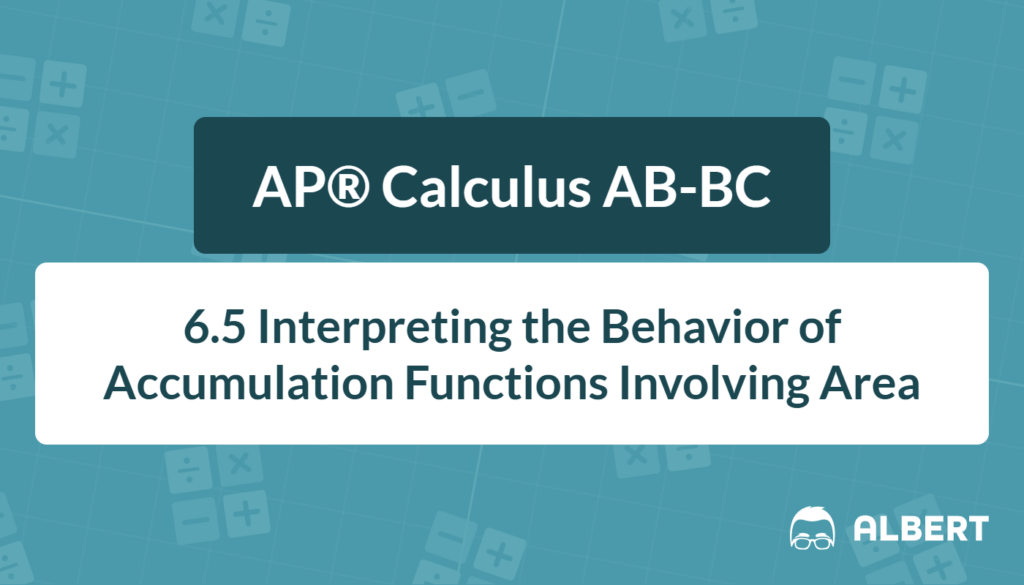Ever wondered how your phone shows a running total of data usage? Behind that smooth animation sits the same mathematics that powers river‐flow totals, mileage trackers, and population growth counters. Continuous running totals are modeled by accumulation functions. This article explains what an accumulation function is, how to predict its shape (aligned with AP® Calculus Unit 6.5), and how to analyze it graphically, numerically, and analytically.
What We Review
What are Accumulation Functions?
Definition and Notation
An accumulation function adds up the values of another function, usually a rate. The standard notation is
g(x)=\int_{a}^{x} f(t)dt- f(t) is called the integrand and often represents a rate.
- a is the lower limit—the starting time or position.
- g(x) is the total, or “area so far,” from t=a to t=x.
Why the Lower Limit “a” Matters
Because integration accumulates net area, changing a shifts every output by a constant. Therefore, two students can pick different starting points and still describe the same shape, only moved up or down.
Example 1
Given f(t)=2t and g(x)=\int_{0}^{x} 2tdt, find a formula for g(x) and evaluate g(3).
Solution
- Integrate the rate.
- g(x)=\int_{0}^{x} 2tdt = \left.t^{2}\right|_{0}^{x}=x^{2}-0 = x^{2}
- Evaluate at 3.
- g(3)=3^{2}=9
Interpretation: When the rate doubles every unit of time, the total growth becomes quadratic.
Building Intuition: The Graphical Story
From f to g: The “Running Area” Picture
Imagine sliding a vertical line from left to right under the graph of f. The area swept out up to position x is g(x). Therefore, wherever the graph of f sits above the axis, area (and thus g) increases; below, g decreases.
Sketching g When Given the Graph of f
Because g'(x)=f(x), think of f as the slope generator for g.
- Where f is positive, g climbs.
- Where f is negative, g falls.
- Where f touches zero, g levels out.
Example 2: Sketching by Eye
Suppose the graph of f is a triangle above the x‐axis from 0 to 2, then a triangle of equal size below from 2 to 4.
- Over 0\le x\le2 the area grows, so g ascends.
- Over 2\le x\le4 equal negative area cancels earlier gains, so g descends back to its starting value.
- Thus g peaks at x=2 and returns to zero at x=4.
Students should sketch a smooth hill peaking at 2 and ending where it began at 4.
Section 6.5—Behavior of Accumulation Functions
Quick Links Between f and g
Because differentiation and integration are inverses,
g'(x)=f(x), \qquad g''(x)=f'(x)Therefore,
- Sign of f → increasing/decreasing of g.
- Zeros of f → critical points of g.
- Extrema of f → inflection points of g.
Example 3: Algebraic Analysis of Accumulation Functions
Given f(t)=t^{3}-3t and g(x)=\int_{0}^{x} (t^{3}-3t)dt, identify where g increases, decreases, and its concavity.
Step 1 – Find where f is positive or negative.
Factor: f(t)=t(t^{2}-3) giving zeros at t=-\sqrt{3},0,\sqrt{3}. A quick sign chart shows
- Negative on (-\infty,-\sqrt{3}) and (0,\sqrt{3})
- Positive on (-\sqrt{3},0) and (\sqrt{3},\infty)
Hence, g
- decreases where f<0
- increases where f>0
Step 2 – Concavity of g.
Because g''(x)=f'(x)=3x^{2}-3, set 3x^{2}-3=0 to find inflection points at x=\pm1. Testing intervals shows
- Concave down for |x|<1
- Concave up for |x|>1
A summary sentence: Therefore, g rises on (-\sqrt{3},0) and (\sqrt{3},\infty), falls elsewhere, flips concavity at x=\pm1, and levels out at x=-\sqrt{3},0,\sqrt{3}.
Inflection Points of g via f’s Extrema
Notice f'(x)=0 at x=\pm1; these are extrema of f and inflection points of g. This shortcut saves time on the AP® exam.
Numerical & Verbal Representations
Tables of Values and Riemann-Sum Approximations
Not every exam problem provides a neat formula. Sometimes a table of f values asks for g(b)-g(a). In that case, approximate the integral with left, right, or trapezoidal sums.
Example 4
The table shows velocity v(t)=f(t) (m/s):
| t (s) | 0 | 2 | 4 | 6 |
| v(t) | 3 | 4 | 2 | 1 |
Estimate g(6)=\int_{0}^{6} v(t)dt using the trapezoidal rule with subintervals of length 2.
Solution
\text{Trapezoids}= \frac{2}{2}\big[(3+4)+(4+2)+(2+1)\big]=1\big[7+6+3\big]=16Thus, approximately 16 meters were traveled in 6 seconds.
Common Pitfalls and Helpful Tips
- Confusing f (rate) with g (total).
- Forgetting the constant of integration when the lower limit is not zero.
- Ignoring the lower limit “a” and thereby losing the vertical shift.
- Skipping unit checks—rates accumulate into different units.
Quick Reference Chart
| Term | Meaning |
| Accumulation function | g(x)=\int_{a}^{x} f(t)dt |
| Integrand | f(t) |
| Lower limit | a |
| Total change | g(b)-g(a)=\int_{a}^{b} f(t)dt |
Conclusion
Accumulation functions turn moment-by-moment rates into total amounts. By mastering the links—sign of f ⇒ rise or fall of g; extrema of f ⇒ inflection of g—students can quickly predict shapes, sketch graphs, and interpret tables. Practice switching among algebraic, graphical, and numerical views, and the next AP® FRQ on accumulation function calculus will feel far less intimidating.
Sharpen Your Skills for AP® Calculus AB-BC
Are you preparing for the AP® Calculus exam? We’ve got you covered! Try our review articles designed to help you confidently tackle real-world math problems. You’ll find everything you need to succeed, from quick tips to detailed strategies. Start exploring now!
- 6.4 The Fundamental Theorem of Calculus and Accumulation Functions
- 6.6 Applying Properties of Definite Integrals
Need help preparing for your AP® Calculus AB-BC exam?
Albert has hundreds of AP® Calculus AB-BC practice questions, free responses, and an AP® Calculus AB-BC practice test to try out.








